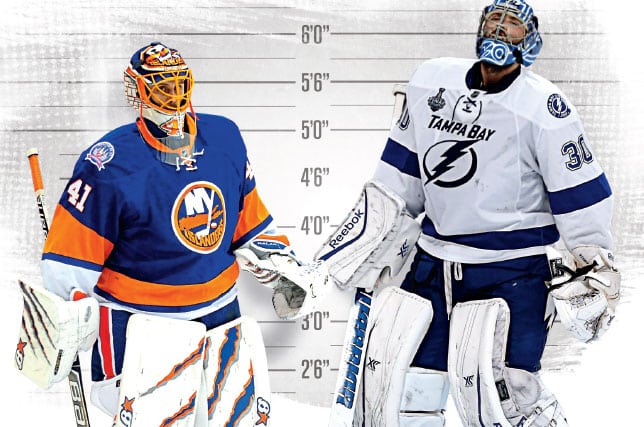
If goalie equipment shrinks, don't expect save percentages to decrease with it
More equipment changes for goalies are on the horizon, but the subtraction could very well end up an addition.
 If goalie equipment shrinks, don't expect save percentages to decrease with it
If goalie equipment shrinks, don't expect save percentages to decrease with itFor many NHL goaltenders looms the ever-present threat of equipment reductions and restrictions. And this off-season, goalies will again be a likely target in the effort to increase scoring. “I know it seems like a broken record or Groundhog Day, but goaltending equipment always comes up,” said Kay Whitmore, the NHL’s director of hockey operations and goaltender equipment. “We’ve done trimming and nipping and tucking here and there, but I think it’s time to look into this a little deeper.”
The two major areas that will be targeted for possible change by 2016-17 are the pants and chest pieces. Whitmore pointed out the unnecessary bulkiness of some keepers as something that could be cut back, adding that goaltenders ranging from the 160-pound, slim, speedy netminder to the 230-pound monster puckstopper shouldn’t be fitting in the same size pant and chest protector. What makes the chest and pant a problem area is the squaring off of the body. What began as a way to get better seals along the ice and along the posts has gotten to the point where it’s difficult to see the differentiation in size between netminders. Whitmore said it’s difficult to tell a goaltender’s “width,” meaning a 6-foot-1 slender netminder looks as wide in his net as his 6-foot-6 counterpart. A groundswell of support for change has begun, even from those who will be impacted most. “Some of the goalies themselves are calling each other out and saying, ‘I just want enough to protect me. I don’t want to lose my job to some guy who’s just taking up space without a lot of skill.’ ” In order to get the equipment to the right size, Whitmore and league officials have been working closely with manufacturers to come up with a solution that both protects goalies and offers a decrease in size. Bauer global brand manager Spencer Freer said Whitmore has been involved in a number of discussions with the company about where equipment is heading and that the NHL simply wants to reduce size, not hinder performance. “We include the NHL in a lot of the development of our products,” Freer said. “When we start to get true samples, we take it to the NHL and we walk through the products, exactly what we’re trying to do, and it’s always been extremely well received.” Technological advancements in equipment would be a way to counteract a loss in size, but even if equipment does get reduced, goalies are best to wait before they cry about getting a raw deal. Since pad size shrunk from 12 to 11 inches for 2005-06, save percentage has actually increased. One reason, said former NHL netminder Steve Valiquette, was because movement speed was increased with the decrease in bulk. Freer said a similar effect could take place with a reduction in upper-body protection. “When they start to shrink the pant and the chest and arm, guys are going to start to understand that they are that much more mobile,” Freer said. “The position is just going to have to evolve even more. The goaltenders are just going to become more athletic.”
This is an edited version of a feature that appeared in the January 25 edition of The Hockey News magazine. Get in-depth features like this one, and much more, by subscribing now.


